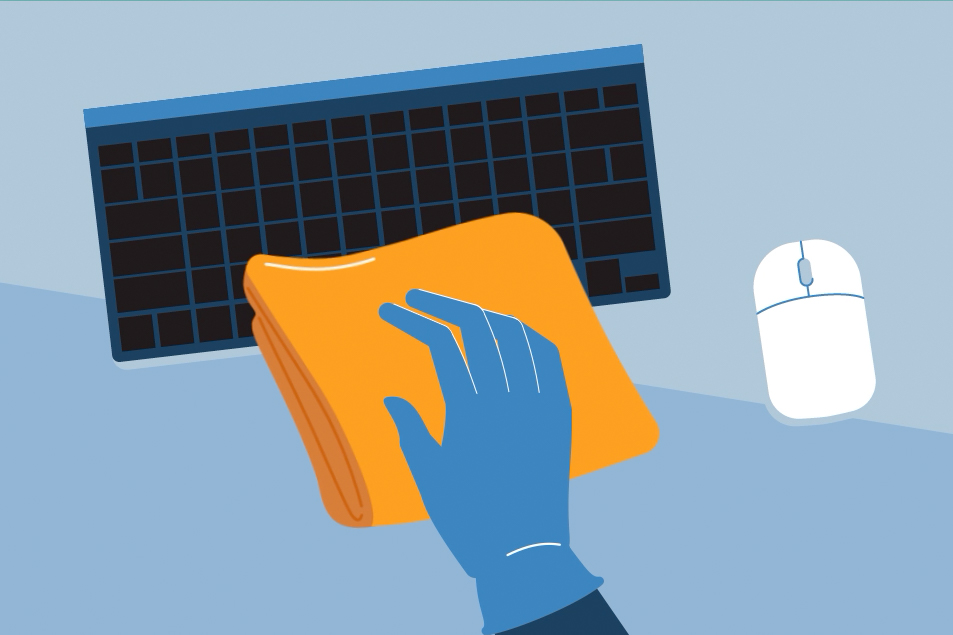

How to Disinfect the Workplace to Help Prevent the Spread of COVID-19
By Grainger Editorial Staff 6/9/20


There are many steps that employers can take to help prevent the spread of COVID-19 in the workplace. OSHA recommends classifying job duties according to COVID-19 exposure risk and implementing control measures appropriate to risk levels. There are also many social distancing measures that can be considered. But even with these precautions, it's possible that people who are sick may spend time at a work facility. If this happens, OSHA and the CDC recommend cleaning and disinfecting the workplace to help prevent the spread of the illness.
When someone in the workplace is sick with COVID-19, the CDC recommends that employers take these steps to clean and disinfect the facility:
- Close off the areas that were used by the person who is sick, including common areas and bathrooms.
- Open exterior doors and windows to promote outdoor air circulation in those areas.
- Wait 24 hours to clean, if possible.
- Clean and disinfect all areas used by the person who is sick. Don't forget touch screens, keyboards and other shared electronic equipment.
If it has been more than seven days since the person who is sick was at the facility, the CDC does not recommend going beyond routine cleaning procedures.
When cleaning an area that may be contaminated, use EPA-registered disinfectants that meet the agency's criteria for effectiveness against SARS-CoV-2, the virus that causes the coronavirus disease 2019 (COVID-19). Hard non-porous surfaces that are visibly dirty should be pre-cleaned with soap and water before disinfecting. Because SARS-CoV-2 is an enveloped virus, it's one of the easiest types of virus to kill, according to the EPA, which maintains a list of disinfectants that it considers effective against the virus. This list also includes some products that meet the EPA's more stringent criteria for effectiveness against harder-to-kill viruses and emerging viral pathogens.
When using a disinfectant, read and follow the directions on the product's label, which will explain how to use it safely and effectively. It's important that the treated surface be visibly wet for a certain length of time—this is called the contact time. Required contact times can be as short as 15 seconds or as long as 30 minutes, depending on the product. The EPA lists the contact time for each of its approved disinfectants and provides information about the surfaces on which the disinfectant can be used.
Most disinfectants are intended to be used only on hard, nonporous surfaces, such as doorknobs and stainless-steel counters. For soft porous surfaces, visible contamination should be removed first and cleaners that are appropriate for use on the surfaces should then be used. After cleaning, if the items can be laundered, they should be laundered in accordance with the manufacturer’s instructions using the warmest water possible and then dried completely. If they cannot be laundered, then the CDC recommends using EPA-approved disinfectants that are suitable for porous surfaces.
According to OSHA, it's appropriate to continue to use routine procedures such as pre-cleaning surfaces before applying the disinfectant for the indicated contact time. However, OSHA advises against using compressed air or water sprays to clean surfaces that are potentially contaminated, since this may aerosolize the infectious material, propelling it into the air in particles small enough to remain airborne for long periods of time.
Commonly Asked Questions
Q: What kind of protection should be worn when cleaning an area that's potentially contaminated with SARS-CoV-2?
A: When dealing with potential SARS-CoV-2 contamination, the CDC recommends wearing disposable gloves and gowns for all cleaning tasks, including handling trash. When cleaning is finished, workers should take off gloves and gowns carefully to avoid contaminating themselves or their surroundings. Additional PPE may be required to protect against exposure to hazardous cleaners or disinfectants, according to OSHA's PPE standards for general industry. Consult manufacturers' instructions and the product safety data sheets (SDSs) for more guidance on what PPE may be required, and read this article for tips on understanding SDSs. If the area is contaminated with potentially infectious materials such as body fluids or blood, workers may also need face masks and eye protection, according to OSHA. Keep in mind that cloth face coverings are not considered PPE. Learn more about OSHA's bloodborne pathogens standard here.
Q: What kind of disinfectant should be used to clean in an area that may be contaminated with the virus that causes COVID-19?
A: Use EPA-registered disinfectants that meet the agency's criteria for effectiveness against SARS-CoV-2, the virus that causes the coronavirus disease 2019 (COVID-19).
Q: What is disinfectant contact time?
A: The contact time is the length of time that the treated surface must be visibly wet for the disinfectant to be effective. The EPA lists contact times for its approved disinfectants. These times can be as short as 15 seconds or as long as 30 minutes, depending on the product.
The information contained in this article is intended for general information purposes only and is based on information available as of the initial date of publication. No representation is made that the information or references are complete or remain current. This article is not a substitute for review of current applicable government regulations, industry standards, or other standards specific to your business and/or activities and should not be construed as legal advice or opinion. Readers with specific questions should refer to the applicable standards or consult with an attorney.






